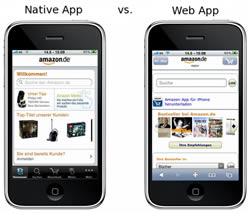Difference Between HTML5 and Native Apps
Key difference: HTML5 is the fifth revision of the HTML standard. HTML stands for HyperText Markup Language. It is a well known mark up language used to develop web pages. The core aims of HTML5 have been to improve the language with support for the latest multimedia. Native Apps, on the other hand, are apps that an application program that has been developed for use on a particular platform or device, such as Android or iOS.
The main difference between HTML5 and Native Apps is that an HTML5 application is one that runs on a web server, usually in a web browser. A native application is one that runs directly on Android and iOS devices and is purchased or downloaded from the relevant app stores.
 HTML5 is the fifth revision of the HTML standard. HTML stands for HyperText Markup Language. It is a well known mark up language used to develop web pages. It has been around for a long time and is commonly used in webpage design. XML or Extensible Markup Language defines a set of rules for encoding documents in a format that can be read by both, human and computer.
HTML5 is the fifth revision of the HTML standard. HTML stands for HyperText Markup Language. It is a well known mark up language used to develop web pages. It has been around for a long time and is commonly used in webpage design. XML or Extensible Markup Language defines a set of rules for encoding documents in a format that can be read by both, human and computer.
HTML is written using HTML elements, which consist of tags, primarily and opening tag and a closing tag. The data between these tags is usually the content. The main objective of HTML is to allow web browsers to interpret and display the content written between the tags. The tags are designed to describe the page content. HTML comes with predefined tags. They allow one to insert images, text, videos, forms and other pieces of content together into a cohesive webpage.
Elements of HTML are the basic building blocks of all websites. HTML allows images and objects to be embedded in the webpage. It can also be used to create interactive forms. HTML also provides the means to create structured documents. It does this by denoting structural semantics for text such as headings, paragraphs, lists, links, quotes and other items. However these days, web pages are rarely designed using only HTML. HTML allows for the programmer to embed scripts written in languages such as JavaScript, which many often do. This changes the look and behavior of the HTML web pages.
The core aims of HTML5 have been to ‘improve the language with support for the latest multimedia while keeping it easily readable by humans and consistently understood by computers and devices, such as web browsers, parsers, etc.’ HTML5 supercedes HTML 4, as well as XHTML 1 and DOM Level 2 HTML. Additionally, as of December 2012, HTML5 is W3C Candidate Recommendation.
HTML5 aimed to address the variety of mixture of features introduced by various specifications by various browsers. It also aimed to address the many syntax errors in existing web documents. Additionally, it attempts to define a single markup language that can be written in either HTML or XHTML syntax. It is also backward compatible with the previous HTML versions.
 Native Apps, on the other hand, are apps that an application program that has been developed for use on a particular platform or device, such as Android or iOS. The advantage of native applications is that they can interact with and take advantage of operating system features and software of that particular platform.
Native Apps, on the other hand, are apps that an application program that has been developed for use on a particular platform or device, such as Android or iOS. The advantage of native applications is that they can interact with and take advantage of operating system features and software of that particular platform.
Native Apps can also take advantage of the latest technology available on mobile devices because they are specifically made for that device or platform. Such as all Android devices or Apple phones will probably have a camera or an active GPS system, whereas HTML5 applications which may be run on desktop browsers may or may not have access to a camera and definitely not to a GPS system.
A native app is typically downloaded and installed on the platform. It may or may not require a constant Internet connection to run. It may be stored on the mobile device out of the box, or it can be downloaded from a public or private app store. The data linked with the app is also stored on the device. However, the data may stored remotely, such as on a cloud and be accessed by the app.
Some differences between HTML5 and Native Apps:
- HTML5 applications are designed using HTML, CSS, and JavaScript. Native Apps are designed using Objective C or Java.
- HTML5 applications run on a Web server through a web browser, Native Apps run on Android or iOS.
- HTML5 applications can deployed to other platforms via a native harness. These apps are called hybrid apps.
- Native apps cannot be easily ported to other platforms.
- HTML5 is compliant on most modern browsers. Native apps are compliant on their own platforms.
- HTML5 faces challenges in accessing device-native features across all mobile browers.
- HTML5 faces challenges in rendering graphically-rich user interfaces and data presentations.
- HTML5 has the advantage of openness. It need not conform to the standards of any single company.
- HTML5 need not share a cut of the app revenue with the company hosting the platform.
- HTML5 is a bit slow in supporting new phone features as the device makers innovate.
- HTML5 and native apps face different but serious fragmentation challenges.
Image Courtesy: w3.org, krify.com









Comments
Great post. Did you write it yourself?
Google Website
Fri, 01/31/2014 - 17:11
Add new comment